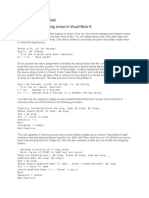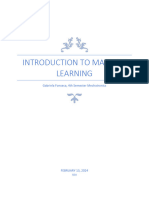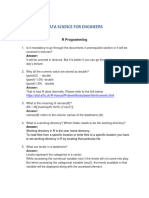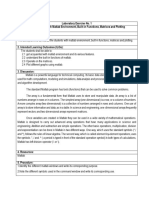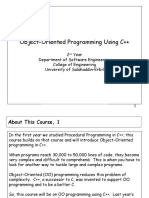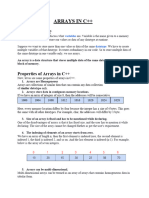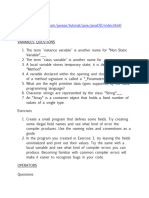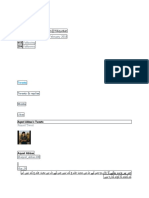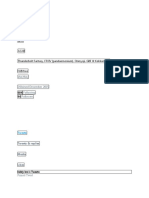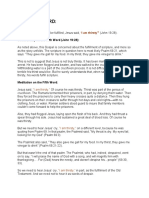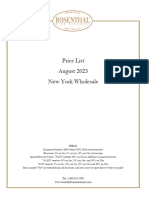CSP Lab Manual 9
CSP Lab Manual 9
Uploaded by
ẄâQâŗÂlïCopyright:
Available Formats
CSP Lab Manual 9
CSP Lab Manual 9
Uploaded by
ẄâQâŗÂlïOriginal Description:
Original Title
Copyright
Available Formats
Share this document
Did you find this document useful?
Is this content inappropriate?
Copyright:
Available Formats
CSP Lab Manual 9
CSP Lab Manual 9
Uploaded by
ẄâQâŗÂlïCopyright:
Available Formats
Mohammad Ali Jinnah University Islamabad
Department of Computer Science,
Faculty of Computing
Lab Manual for Computer Programming
Lab 12: Multi-Dimensional Arrays and Manipulating Sequence
of Characters using C++ string Data-type
Lab 12: Multi-Dimensional Arrays and Introduction to Functions
Table of Contents
1.
Introduction
104
2.
Activity Time-boxing
104
3.
Objective of the Experiment
104
4.
Concept Map
105
4.1
4.2
4.3
5.
6.
7.
String manipulation
Multi-Dimensional Arrays
Summary
106
Error! Bookmark not defined.
107
Home work before Lab
107
5.1
5.2
107
107
Problem Solution Modeling
Practices from home
Procedure & Tools
108
6.1
6.2
6.3
108
108
108
Tools
Setting-up Visual Studio 2008
Walkthrough Task
Practice Tasks
7.1
7.2
7.3
7.4
7.5
110
Practice Task 1
Practice Task 2
Practice Task 3
Out comes
Testing
111
111
Error! Bookmark not defined.
111
111
8.
Evaluation Task (Unseen)
112
9.
Evaluation Criteria
112
10.
Further Readings
112
10.1
112
Slides
Department of Computer Science,
MAJU, 2013
P a g e | 103
Lab 12: Multi-Dimensional Arrays and Introduction to Functions
Lab 12: Multi-Dimensional Arrays and Manipulating
Sequence of Characters using C++ string Data-type
1. Introduction
In this lab, you will learn and practice multi-dimensional arrays, particularly 2-dimensional arrays. In the
Lab-11, you have already learned how to deal with data consisting of sequence of characters (text).
Sequence of characters can be manipulated using character arrays (char [ ]). Actually, character array is
the way C language deals with the text data; therefore it is also called C-String.
The section 2 presents a table that outlines some major activities and tasks you will do as the part of this
lab. Table 1 also provides the estimated-time for each activity, which will help you to organize your tasks
well. Section 3 presents some of the learning objectives for this lab. Section 4 (Concept Map) discusses
and provides a comprehensive introduction of the topic. Section 5 lists the set of home-tasks you are
required to complete before this lab. Section 6 presents a walkthrough task that you will do as the first
practical activity during your lab. The walkthrough task has many small steps which you should follow as
directed in-order to complete the task and to get the desired output. After that, you will be ready to
work on some tasks on your own. The section 7 lists practice tasks for this purpose. As the part of
section 8, your lab instructor will give you some tasks at runtime and will evaluate those according to
the criteria mentioned in section 9. Section 10 lists some further reading links.
Note: Before coming to the lab, you are required to read Lab contents until section 5. You will
start your practical work from section 6 onward in the lab.
Relevant Lecture Readings:
a) Lecture No. 1718
b) Text Book: Computer Programming by D.S. Malik, second edition, pages: 504521
2. Activity Time-boxing
Table 1: Activity Time Boxing
Task No.
5.1
6.2
6.3
7
8
Activity Name
Evaluation of Design
Setting-up Visual Studio
Specialized Tasks
Practice tasks
Evaluation Task
Total Time
Activity time
20 mins
5 mins
30 mins
20 mins for each task
55 mins for all assigned task
Total Time
20 mins
5 mins
30 mins
60 mins
55 mins
170 mins
3. Objective of the Experiment
Introducing multi-dimensional arrays in particular 2D arrays.
To get basic understanding of string data-type.
To get familiarize and practice basic string functions.
Department of Computer Science,
MAJU, 2013
P a g e | 104
Lab 12: Multi-Dimensional Arrays and Introduction to Functions
Learning how to structure code to improve code-readability and code reuse.
4. Concept Map
As you have already learned in the lab 11, arrays are basically a collection of data-items or values all
based on same data-type. In C++, we can create arrays having single-dimension (a list), two dimensions
(a table), and even more than two dimensions. This lab will focus on two-dimensional arrays and will
also provide introduction of strings.
To deal with sequence of characters, C++ provides its own specialized data-type based on string class. In
C++, std::string is the standard way to deal with the sequence of characters. A string variable can store
sequence of characters, letters, symbols (*, $, %), and non-keyboard characters such as escape
sequences [Lab-1]. Some of the examples of text that a string variable can store are: Hello,
BC050102, I Love C++ Programming!, Grade:\n\tA.
The string data-type provides many built-in functions to ease the tasks related to text manipulation.
Some of the example tasks which can be performed using built-in string functions are: text comparison,
combining two text values (concatenation), finding occurrence of some character or sequence of
characters in a text, and replacing/erasing some parts of the text. The Appendix A shows some of the
most used string functions along their parameter specification/meaning. String is not the built-in data
type rather it is part of the C++ standard library. Therefore, to use string types you have to include the
corresponding library in the program using include statement:
#include <string>
4.1 String manipulation using specialized data-type
C/C++ provides character data-type to deal with individual character values. In C, character arrays are
used to deal with more than one characters or text. This character array is often referred as C-String.
C++ provides a specialized data-type (called string) to handle or manipulate text. A string type variable
can store same information but provides many useful methods/functions to process the text. C++s
string type has several other advantages too over C-String (character array) as discussed below:
4.1.1 Memory Storage
One of the main drawbacks of using character array is that it has fixed size in memory, whether or not
you utilize full allocated space. For example: if you create a character array based on 80 elements
(characters), in memory 80 bytes will be reserved for it. If you store Pakistan in this character array
only 9 array elements (including \0 or null character) will be utilize, other 71 bytes will remain allocated
but un-utilized. Strings have variable sizes and the amount of space they take up in memory depends on
the length of the string.
4.1.2 String Functions
C++ string type provides many built-in functions to ease text handling. Thats why using string type
instead of character arrays will ease writing programs in less time and with shorter source code.
Furthermore, you do not have to implement major text manipulation functionalities by yourself. In
Appendix A list of basic string functions is provided.
Department of Computer Science,
MAJU, 2013
P a g e | 105
Lab 12: Multi-Dimensional Arrays and Introduction to Functions
4.2 Multi-Dimensional Arrays
A 2 Dimensional (2D) array represents set of rows and columns in the form of a table. To declare a 2D
array, you have to provide two size values; first size represents number of rows while the second size
values represents number of columns of a 2D array.
Column index
0
int marks_of_three_students[3][5];
1
Row index
Above C++ code creates a two dimensional array having 3 rows (indexed from 02) and 5 columns
(indexed from 04). In a 2D array, accessing an array element requires two index values (one for row
and other for column). For examples: cout<<marks_of_three_students[1][3]; Prints value of the
element at 2nd row and 4th column.
As you have learned that it is very convenient to access singe dimensional arrays using for-loops.
Similarly, to conveniently access elements of a 2D array, generally nested for-loop (to generate both the
row index and column index) is used as shown in the below code example:
for(int i=0;i<3; i++) //For Row index
for(int j=0;j<5; j++) // For Column index
cin>>marks_of_three_students[i][j];
Similar to one-dimensional arrays, 2D arrays can also be initialized. To initialize a 2D array, you have to
provide comma ( , ) separated lists of values (enclosed in braces { and } ) where each list
corresponds to specific row of the 2D array. All values to be used in initialization should belong to the
same data-type the 2D array processes. In the following example, a 2D named table (int type) is created
and being initialized:
int table[3][4] = {{7, 9, 3, 21}, {30, 1, 9, 16},{45, 87, 4, 10}};
The above C++ statement will create a 2D array having 3 rows and 4 columns (total 12 int type
elements). First list of numbers will be use to initialize row-0, second list of values are placed in row-1,
and the third list at row index-2 as shown below:
Row index
21
30
16
45
87
10
Department of Computer Science,
MAJU, 2013
Column index
P a g e | 106
Lab 12: Multi-Dimensional Arrays and Introduction to Functions
4.3 Summary
Arrays are very useful data-structure that helps to process large amount of data of same-type.
Arrays simplify coding of the programs (processing large amount of similar data) using fewer
code lines as compared to the non-array based C++ program having same functionality.
5. Homework before Lab
5.1 Problem Solution Modeling
Write the pseudo-code of the following task. You are required to bring this code with you and submit
to your lab instructor.
4.1.1 Problem description: Write pseudo-code of a program that calculates the sum of odd numbers of
a matrix. First, create a 2D array having 5 rows and 5 columns. After that, the program should sum all
those numbers in the matrix which are odd. In the end, print the calculated sum.
5.2 Practices from home
4.2.1 Task-1
Write a C++ program that displays the row numbers of a matrix containing at least two prime numbers.
First, the program should create a 2D array (5 rows, 5 columns). Then, ask the user to input values in the
matrix or 2D array. After that, program should display row number (or index) which has at least two
prime numbers. If no row (of the matrix) contains at least two prime numbers then the program should
display the message No row found containing two prime numbers.
Sample Input:
Please enter data for matrix of 5 x 5:
2 6 18 49 8
33 15 11 17 13
8 21 47 37 28
12 12 12 12 12
2 3 4 5 6
Sample Output: Row number 2, 3, 5 contains prime numbers.
4.2.2 Task-1
Write a C++ program that asks the user to enter a string. The program should count total number of
vowels in the input string. The output of the program should report vowel count for each vowel
character (a, e, i, o , u), and total or sum of all vowel count.
Sample Input:
Please enter a string: i love C++ programming!
Sample Output:
Total Vowels: 6
A: 1
E: 1
I: 2
O: 2
Department of Computer Science,
MAJU, 2013
P a g e | 107
Lab 12: Multi-Dimensional Arrays and Introduction to Functions
U: 0
6. Procedure & Tools
6.1 Tools
Visual Studio 2008.
6.2 Setting-up Visual Studio 2008
[Expected time = 5 mins]
Setup Visual Studio and make a project named SumRowCol. For setup details please refer to the Lab-1
(Section 6.2).
6.3 Walkthrough Task 1
[Expected time = 30 mins]
Write a C++ program which calculates sum of each column and row separately. For this, first create a 2D
array (3 rows, 5 columns) and then ask the user to input values in the array. After that, first calculate
sum of each row separately and display that sum. Then, calculate sum of each column separately and
display that sum on the screen. To achieve such output, you need to follow the following instructions.
6.3.1 Writing Code
In the source file created in the project SumRowCol write following C++ code:
Department of Computer Science,
MAJU, 2013
P a g e | 108
Lab 12: Multi-Dimensional Arrays and Introduction to Functions
Figure 1: C++ code for sum Row-Col program
6.3.2 Compilation
After writing the code, compile your code according to the guidelines mentioned in Lab-1 (section 6.3.2)
6.3.3 Executing the Program
A sample output after running the program is shown below:
Figure 2: Final output of sum Row-Col program.
6.4 Walkthrough Task 2
[Expected time = 30 mins]
Write a C++ program that counts total words in a sentence. First, get input in a string variable prg for a
paragraph (terminated by enter key). Your program should count total number of words in the
paragraph (using find function of string) and print that value on screen as follows:
You entered 20 words for the paragraph.
To achieve such output, you need to follow the following instructions.
6.4.1 Writing Code
Department of Computer Science,
MAJU, 2013
P a g e | 109
Lab 12: Multi-Dimensional Arrays and Introduction to Functions
In the source file created in the project WordCounter write following C++ code:
.Figure 1: C++ code for word counter program
6.4.2 Compilation
After writing the code, compile your code according to the guidelines mentioned in Lab-1 (section 6.3.2)
6.4.3 Executing the Program
A sample output after running the program is shown below:
Figure 2: Final output of word count program
7. Practice Tasks
This section will provide more practice exercises which you need to finish during the lab. You need to
finish the tasks in the required time. When you finish them, put these tasks in the folder specified by the
lab instructor.
Department of Computer Science,
MAJU, 2013
P a g e | 110
Lab 12: Multi-Dimensional Arrays and Introduction to Functions
7.1 Practice Task 1
[Expected time = 30 mins]
Write a C++ program which repeatedly asks the user to enter their contact numbers. Create a string
variable named Phone_No and take the input in the following pattern: +92423672123 where the
first three characters represent country code (e.g., +92 as shown in the example pattern), next two
characters (e.g., 42 according the shown example number) represent the city code, while next 7
characters represent the actual number.
Your task is to display appropriate messages for the numbers belonging to three cities: Islamabad
(having city code 51), Lahore (city code 42), and Karachi (city code: 21). Any number having different
country code or city code must be reported as Un-known number. Please also ensure that the user
must enter the number according to the shown pattern only and the size of the input string must be 12
characters.
7.2 Practice Task 2
[Expected time = 30 mins]
Write a program that creates and then reads a matrix of 4 rows and 4 columns of type int. while reading;
the program should not accept values greater than 100. For any entered value greater than 100, the
program should ask for input repeatedly. After reading all numbers, the system should find the largest
number in the matrix and its location or index values. The program should print the largest number and
its location (row and column).
7.3 Out comes
After completing this lab, student will be able to use string data type and its function for text
manipulation.
7.4 Testing
Test Cases for Practice Task-1
Sample Inputs:
Enter a number: +92214352682
Sample Outputs:
This number belongs to Karachi
Do you want to enter another number (y/n): n
End of program. Bye!
Test Cases for Practice Task-2
Sample Input-1
13, 15, 76, 85
10,
4,
73, 91
1,
8,
17, 52
74, 3, 15, 26
Sample Input-2
77, 1, 19, 74
Sample output 1
Largest values in matrix is 91 at row 1 column 3
Sample output 2
Department of Computer Science,
MAJU, 2013
P a g e | 111
Lab 12: Multi-Dimensional Arrays and Introduction to Functions
54,
3,
22, 62
11, 19,
6,
Largest values in matrix is 89 at row 3 column 1
11
32, 89, 15, 85
Practice Tasks
T1
T2
T3
Confirmation
8. Evaluation Task (Unseen)
[Expected time = 55 mins]
9. Evaluation Criteria
The evaluation criteria for this lab will be based on the completion of the following tasks. Each task is
assigned the marks percentage which will be evaluated by the instructor in the lab whether the student
has finished the complete/partial task(s).
Sr. No.
1
2
3
4
5
6
Task No
4.1
6
7.1, 7.2, and 7.3
8
Table 2: Evaluation of the Lab
Description
Problem Modeling
Procedures and Tools
Practice tasks and Testing
Evaluation Tasks (Unseen)
Comments
Good Programming Practices
Marks
20
10
35
20
5
10
10. Further Readings
10.1 Slides
The slides and reading material can be accessed from the folder of the class instructor available at
\\dataserver\jinnah$\
Department of Computer Science,
MAJU, 2013
P a g e | 112
You might also like
- Treasurer's AffidavitDocument1 pageTreasurer's AffidavitLENGLENG0483100% (3)
- Contract of Legal Services SampleDocument1 pageContract of Legal Services SampleBanderado Law Offices100% (1)
- CS 2255 Final Exam SampleDocument10 pagesCS 2255 Final Exam SamplecanadaspiritNo ratings yet
- Analysis and Forecasting of Crude ModelsDocument13 pagesAnalysis and Forecasting of Crude ModelsMartín E. Rodríguez AmiamaNo ratings yet
- Soal Yang Sering Muncul Di MTCNA MikroTikDocument4 pagesSoal Yang Sering Muncul Di MTCNA MikroTikdestu kurniadi88% (8)
- Python Notes by Jobhunter TeamDocument255 pagesPython Notes by Jobhunter TeamChinamayi ChinmayiNo ratings yet
- AP Lab Assignment 4Document34 pagesAP Lab Assignment 4RAHUL KUMAR100% (1)
- Chapter 4 (Arrays and Functions)Document32 pagesChapter 4 (Arrays and Functions)rahul015januaryNo ratings yet
- Assigning and Returning Arrays in Visual Basic 6Document13 pagesAssigning and Returning Arrays in Visual Basic 6lalithaNo ratings yet
- Module 3Document22 pagesModule 3Naveen MathadNo ratings yet
- 15 122 hw2Document10 pages15 122 hw2Ryan SitNo ratings yet
- Ds Lab 2Document7 pagesDs Lab 2Habib rehmanNo ratings yet
- Takeaway - Computer ProgrammingDocument4 pagesTakeaway - Computer ProgrammingIvy CheroNo ratings yet
- PF 6Document22 pagesPF 6mrsfahad550No ratings yet
- Lab 02Document7 pagesLab 02jrdnadrNo ratings yet
- Itc Lab Report 12: OjectiveDocument5 pagesItc Lab Report 12: OjectiveMuhammad Moaz Awan FastNU0% (1)
- Lab 06Document8 pagesLab 06سفيان طهراويNo ratings yet
- Introduction To Machine Learning Report 1Document17 pagesIntroduction To Machine Learning Report 1arrepio cosmicoNo ratings yet
- (Handout) Lab 1 - C Programming and MakefilesDocument13 pages(Handout) Lab 1 - C Programming and Makefilesmir.inzamam200No ratings yet
- Operating Systems Lab Assignment 5: Developing Multi-Threaded ApplicationsDocument7 pagesOperating Systems Lab Assignment 5: Developing Multi-Threaded Applicationsapi-526395450No ratings yet
- Master of Science in Information Technology (MScIT-NEW) - Semester 3Document29 pagesMaster of Science in Information Technology (MScIT-NEW) - Semester 3Birendra SinghbNo ratings yet
- Data Struc Lab 01Document5 pagesData Struc Lab 01Eloisa LecarozNo ratings yet
- Visual Programming Paper 2021Document6 pagesVisual Programming Paper 2021Sana KhanNo ratings yet
- Python by DR SabDocument14 pagesPython by DR SabDukkyNo ratings yet
- CS255 Data Structure Lab ManualDocument29 pagesCS255 Data Structure Lab ManualJagadeesh KumarNo ratings yet
- Introduction To Machine Learning Report 1Document17 pagesIntroduction To Machine Learning Report 1arrepio cosmicoNo ratings yet
- DataStructureAlgorithm ManualDocument48 pagesDataStructureAlgorithm ManualSyed Umar NasarNo ratings yet
- Data Structurs Through C++Document98 pagesData Structurs Through C++shrutiNo ratings yet
- Java ExamDocument3 pagesJava Exammdfire0No ratings yet
- CS36 Lab 5Document4 pagesCS36 Lab 5Syed ZaidiNo ratings yet
- Sppu PPL Nov 2017 AnswersDocument15 pagesSppu PPL Nov 2017 Answersranjeetjagtap100% (1)
- Lab Workbook: 17Cs3554 - Competitive Coding LabDocument104 pagesLab Workbook: 17Cs3554 - Competitive Coding Labmanohar sikhakolli100% (1)
- Week 1Document12 pagesWeek 1a1extrusion2021No ratings yet
- Lab IntroductionDocument15 pagesLab IntroductionSuhaib AwanNo ratings yet
- LabExercise 1 - Familiarization With MATLABDocument19 pagesLabExercise 1 - Familiarization With MATLABQueenie Rose PercilNo ratings yet
- C# TutorialDocument132 pagesC# TutorialHari Krishnan Anbaesivam100% (1)
- Data Strcuture Lab - 01 AIUBDocument13 pagesData Strcuture Lab - 01 AIUBmahin ramchagolNo ratings yet
- R LecturesDocument10 pagesR LecturesApam BenjaminNo ratings yet
- College of Information Technology: CSC 103: Computer Programming For Scientists and EngineersDocument47 pagesCollege of Information Technology: CSC 103: Computer Programming For Scientists and Engineersbhg9No ratings yet
- BSIT 22 Main PG 1 168Document168 pagesBSIT 22 Main PG 1 168Rajesh MkNo ratings yet
- OO C++ NotesDocument227 pagesOO C++ NotesDayton Good Kush AllenNo ratings yet
- Arrays in C++Document8 pagesArrays in C++ahmed mohamedNo ratings yet
- CSE 1020 3.0 Introduction To Computer Science I Final Exam, Summer 2012 90 MinutesDocument8 pagesCSE 1020 3.0 Introduction To Computer Science I Final Exam, Summer 2012 90 MinutesexamkillerNo ratings yet
- Comp 1 HWDocument11 pagesComp 1 HWTienanh NguyenNo ratings yet
- Bca-Hc-4036: Object Oriented Programminf in C++Document4 pagesBca-Hc-4036: Object Oriented Programminf in C++Prasanta DebNo ratings yet
- Object Oriented ProgrammingDocument53 pagesObject Oriented ProgrammingAdnan Alam KhanNo ratings yet
- Lab Manual 3Document11 pagesLab Manual 3Make it possibleNo ratings yet
- Data Structure & AlgorithmDocument25 pagesData Structure & AlgorithmMELANIE LADRILLO ABALDENo ratings yet
- C, CDocument44 pagesC, Capi-3760815No ratings yet
- Homework 03Document3 pagesHomework 03jayaNo ratings yet
- Assignment 3 PDFDocument5 pagesAssignment 3 PDFanon_929121264No ratings yet
- CS 106B Class NotesDocument14 pagesCS 106B Class NotesChengineNo ratings yet
- Introduction To C++ For Java ProgrammersDocument21 pagesIntroduction To C++ For Java ProgrammersJimmy ZhuNo ratings yet
- c++-5Document31 pagesc++-5Solomon AsfawNo ratings yet
- Introduction To Spectral Analysis and MatlabDocument14 pagesIntroduction To Spectral Analysis and MatlabmmcNo ratings yet
- Java QuestionsDocument9 pagesJava Questionsmyhealth632No ratings yet
- Chapter 8Document20 pagesChapter 8Jojo CansinoNo ratings yet
- Assignment 1Document7 pagesAssignment 1Rakesh BeheraNo ratings yet
- Matlab Tut BasicDocument8 pagesMatlab Tut BasicAndry BellehNo ratings yet
- Handout VectorsDocument18 pagesHandout VectorsJeremy PhoNo ratings yet
- Initializing An Array in Constructor - 902Document6 pagesInitializing An Array in Constructor - 902شازب الماسNo ratings yet
- Answers or Algorithm Year2023Document8 pagesAnswers or Algorithm Year2023pacifiqueishimwejulesNo ratings yet
- Unit 03Document19 pagesUnit 03Prasanna WankhedeNo ratings yet
- Cricket Enthusiastic - Statsman Babar Azam A B de Villers Dale Steyn Lasith MalingaDocument4 pagesCricket Enthusiastic - Statsman Babar Azam A B de Villers Dale Steyn Lasith MalingaẄâQâŗÂlïNo ratings yet
- SanazDocument13 pagesSanazẄâQâŗÂlïNo ratings yet
- #Modisurrenderstochina: New Fix For 5.6 InchDocument6 pages#Modisurrenderstochina: New Fix For 5.6 InchẄâQâŗÂlïNo ratings yet
- Maryam: I Ruined My Life Learning How To Save OthersDocument6 pagesMaryam: I Ruined My Life Learning How To Save OthersẄâQâŗÂlïNo ratings yet
- Aqeel Abbas: ونس تاب یک رحس ِدیما ! Fasttian - - WilayatianDocument14 pagesAqeel Abbas: ونس تاب یک رحس ِدیما ! Fasttian - - WilayatianẄâQâŗÂlïNo ratings yet
- Ali Shanawar: @alishanawar1 New South Wales, Australia Born August 15joined May 2010 Following FollowersDocument10 pagesAli Shanawar: @alishanawar1 New South Wales, Australia Born August 15joined May 2010 Following FollowersẄâQâŗÂlï100% (1)
- The Land of LuckDocument7 pagesThe Land of LuckẄâQâŗÂlïNo ratings yet
- Tiddy Bro: Wolvie BLM Acab Thunderbolt Fantasy, FFXIV (Pandaemonium), Onmyoji, GBF & Kokkuri-San FUB FreeDocument6 pagesTiddy Bro: Wolvie BLM Acab Thunderbolt Fantasy, FFXIV (Pandaemonium), Onmyoji, GBF & Kokkuri-San FUB FreeẄâQâŗÂlïNo ratings yet
- Explore: COVID-19: Updates For The USDocument6 pagesExplore: COVID-19: Updates For The USẄâQâŗÂlïNo ratings yet
- ʜɪɴ ʜ ʜ RetweetedDocument6 pagesʜɪɴ ʜ ʜ RetweetedẄâQâŗÂlïNo ratings yet
- The Aman Project: @theamanproject 16hDocument9 pagesThe Aman Project: @theamanproject 16hẄâQâŗÂlïNo ratings yet
- JohnaholeotooleDocument4 pagesJohnaholeotooleẄâQâŗÂlïNo ratings yet
- Farrukh Saleem: @saleemfarrukh Jun 19Document10 pagesFarrukh Saleem: @saleemfarrukh Jun 19ẄâQâŗÂlïNo ratings yet
- "India and Pakistan": Log inDocument9 pages"India and Pakistan": Log inẄâQâŗÂlïNo ratings yet
- Writing Tagged As DeathDocument3 pagesWriting Tagged As DeathẄâQâŗÂlïNo ratings yet
- ADocument2 pagesAẄâQâŗÂlïNo ratings yet
- The Fifth WordDocument2 pagesThe Fifth WordAlbert WadeNo ratings yet
- Sack Race RulesDocument1 pageSack Race Rulesarly_alcantara100% (2)
- 767 Thesis-0812 PDFDocument196 pages767 Thesis-0812 PDFRahimshaikhNo ratings yet
- Botany TerminologyDocument96 pagesBotany TerminologySashka Toncheva100% (2)
- NY August 2023 PricelistDocument19 pagesNY August 2023 PricelistbobolabaNo ratings yet
- SR - No. Hospital Name Address Pin No Tel - No Mob No. City State PPN Effective Date Email-IdDocument9 pagesSR - No. Hospital Name Address Pin No Tel - No Mob No. City State PPN Effective Date Email-IdMohit Doctors PlacementsNo ratings yet
- PGP Retirement Planning UnlockedDocument9 pagesPGP Retirement Planning UnlockedBharathi 3280No ratings yet
- Mtss Math Unit PlanDocument2 pagesMtss Math Unit Planapi-273303177No ratings yet
- How A Bill Really Becomes A Law Updated 2 19Document1 pageHow A Bill Really Becomes A Law Updated 2 19Levi MolenhourNo ratings yet
- Bushra, Symboles and Themes in The WastelandDocument6 pagesBushra, Symboles and Themes in The WastelandBushra Othman SidiqNo ratings yet
- Key TEST 1Document7 pagesKey TEST 1Hải PhươngNo ratings yet
- WEDE5020POEDocument14 pagesWEDE5020POETatendaNo ratings yet
- Index Esignal Malam - One SheetDocument6 pagesIndex Esignal Malam - One SheetRidwanKrisnadiNo ratings yet
- Batumi: From Strategic Port To Bustling Sea ResortDocument2 pagesBatumi: From Strategic Port To Bustling Sea ResortjessicaNo ratings yet
- Sample Article FormatDocument19 pagesSample Article FormatMis. Occ. - Mariefe MarquitaNo ratings yet
- Ira Gewanter - Style Magazine Aug. 2012 (Page 83)Document1 pageIra Gewanter - Style Magazine Aug. 2012 (Page 83)Ira GewanterNo ratings yet
- Specific Performance MS 1 To 16Document16 pagesSpecific Performance MS 1 To 16Nur AqilahNo ratings yet
- SubRosa Issue6 SingleDocument93 pagesSubRosa Issue6 SinglePeter SealsNo ratings yet
- Pisa Lenie and JustinDocument24 pagesPisa Lenie and Justinlenie bacalsoNo ratings yet
- Year 5 6 Reading Extract and Questions The Railway Children 1Document3 pagesYear 5 6 Reading Extract and Questions The Railway Children 1Mylie RobertsNo ratings yet
- On Self-Love, Egocentrism, and Freedom: We Must "Empty Ourselves" For God To Enter Into UsDocument3 pagesOn Self-Love, Egocentrism, and Freedom: We Must "Empty Ourselves" For God To Enter Into UsNilsonMarianoFilhoNo ratings yet
- Economic Geology of Sri LankaDocument21 pagesEconomic Geology of Sri LankaCharith LiyanageNo ratings yet
- Sales & Distribution Channel TrivaniDocument100 pagesSales & Distribution Channel TrivaniAshok Kumar100% (1)
- Laboratory-Scheme 4Document1 pageLaboratory-Scheme 4Ivan Ray ToyloNo ratings yet
- Lab - Unit 5 - It Act 2000Document15 pagesLab - Unit 5 - It Act 2000Disha MohantyNo ratings yet
- Homework Statistics by CountryDocument8 pagesHomework Statistics by Countrygomuzefoweg3100% (1)








